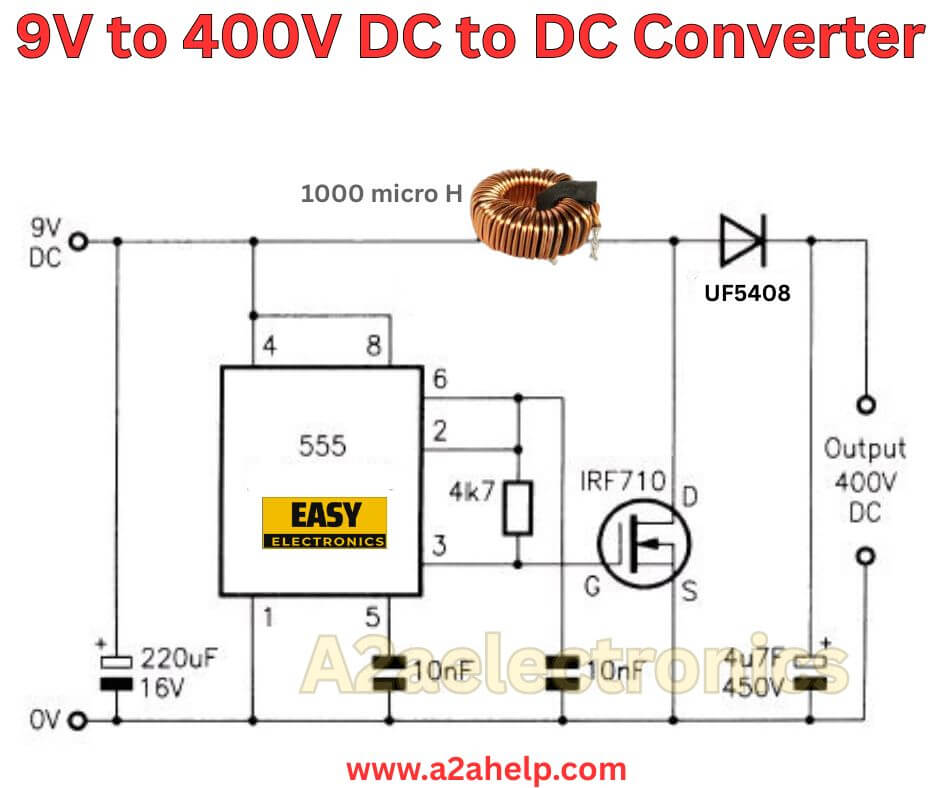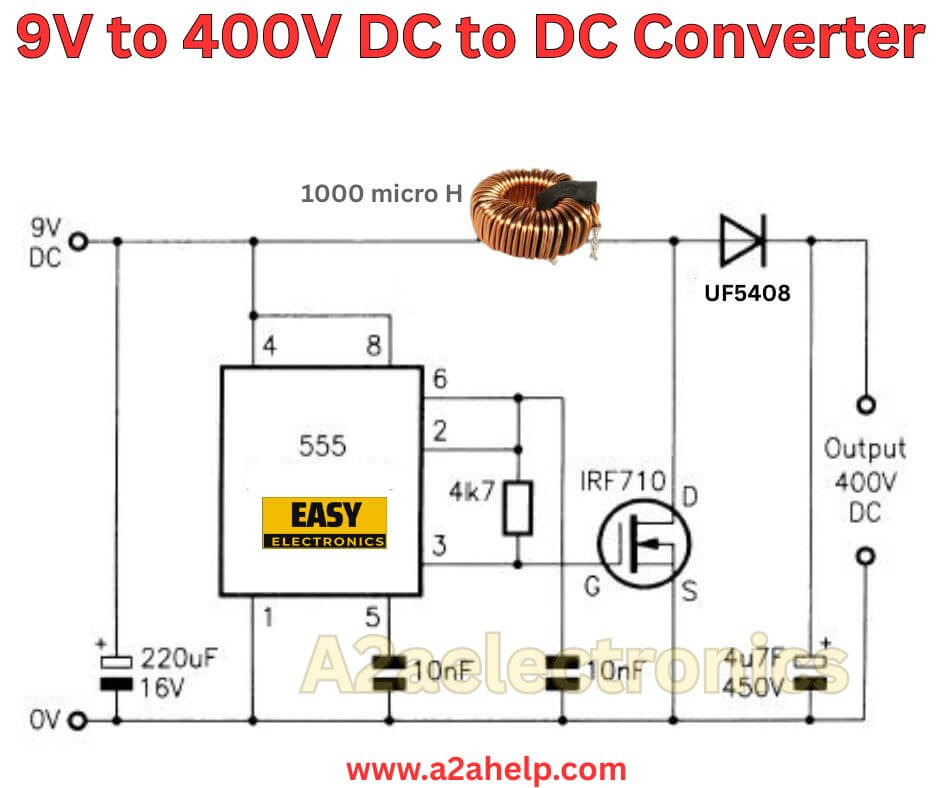Hey friend, if you have ever needed a high voltage supply for something like a Geiger counter, a small Nixie tube display, or even some experimental projects, a 9V to 400V DC to DC converter can be a handy tool to have in your electronics arsenal. As an experienced electronics engineer, I have built several high-voltage converters over the years, and they are fascinating because they push the limits of simple components to achieve big voltage boosts. The circuit we are looking at here, based on common designs for low-power applications, uses a straightforward flyback topology with a 555 timer for switching control. It takes a standard 9V battery input and steps it up to around 400V DC with low current output, perfect for applications where you do not need much power but require that high potential. In this guide, I will analyze the schematic, explain how it works, list the parts, walk you through the build, and offer tips to get it running smoothly. Let’s dive in.
Why Build a 9V to 400V DC to DC Converter?
You might wonder why anyone would build this when you can buy off-the-shelf modules. For starters, it is about learning the principles of power conversion. Boosting voltage from 9V to 400V involves energy storage in magnetic fields, switching, and rectification, which are core concepts in power electronics. I have used similar circuits in portable radiation detectors, where space and battery life are critical. This design is low-power, drawing just a few milliamps at idle, so a 9V battery lasts a long time. It is also customizable—if you need exactly 400V for a specific tube or sensor, you can tweak it easily. Plus, at under $20 in parts, it is cheaper than many commercial high-voltage supplies, and you get the satisfaction of making it yourself. If you are into DIY science projects or just want to experiment with high voltage safely, this is a solid project.
Breaking Down the 9V to 400V DC to DC Converter Circuit
The schematic is a classic flyback converter driven by a 555 timer IC. The 555 generates pulses to switch a MOSFET on and off, building energy in a transformer’s primary winding. When the switch opens, the energy flies back to the secondary, producing high voltage that gets rectified and filtered. Feedback keeps the output stable at 400V. This setup is efficient for low-current loads (up to 1-7mA), which is ideal for Geiger tubes or similar.
Starting from the input, the 9V DC from a battery connects to the 555 timer and the transformer’s primary. The 555 is configured in astable mode to produce a square wave at around 40-55kHz, depending on the load. Resistors and a capacitor set the frequency—typically a 10k resistor, 1k potentiometer for adjustment, and a 0.01μF cap. The output of the 555 drives the gate of an N-channel MOSFET like the IRF840, which can handle high voltages and currents.
The MOSFET switches the primary side of the transformer. For this, you use a small audio transformer or a custom-wound one with a turns ratio of about 1:50 (primary 10 turns, secondary 500 turns on a ferrite core). When the MOSFET is on, current ramps up in the primary, storing energy. When it turns off, the magnetic field collapses, inducing a high voltage spike in the secondary.
On the secondary side, a high-voltage diode (like UF4007 or a 1N4937 stack) rectifies the AC to DC, and a capacitor (0.1μF, 600V rated) smooths it out. To regulate the 400V, a feedback loop uses a voltage divider (high-value resistors like 1MΩ series) to sample the output and feed it back to the 555’s control pin or a comparator. If the voltage rises too high, it adjusts the duty cycle to lower it. For safety, add a zener diode or current-limiting resistor.
This circuit’s waveform is pulsed, so the output is not perfectly smooth, but for many uses, it is fine. Efficiency is around 60-80%, with heat mainly in the MOSFET and transformer. At full load (say 1mA at 400V), input current might be 50-100mA from 9V.

Key Components You Will Need
Here is what to grab. I have included rough costs and tips for sourcing.
- 555 Timer IC: The heart of the oscillator. $0.50, widely available.
- MOSFET: IRF840 or similar N-channel, rated for 500V+ and 8A. $1-2, needs a heatsink.
- Transformer: Small ferrite core with primary 10-20 turns of thick wire (18AWG), secondary 400-500 turns of thin wire (30AWG). Or repurpose a 9V-220V step-down transformer in reverse. $5-10.
- Diode: High-voltage fast recovery, like UF5408 (600V, 3A). $0.50.
- Capacitors: 0.01μF for timing, 0.1μF/600V for output filter, 10μF for input bypass. $1 total.
- Resistors: 10k, 1k pot for timing; 1MΩ x3 for divider; 100Ω gate resistor. $0.50.
- Zener Diodes: For feedback, 5.1V or as needed. $0.50.
- Power Source: 9V battery or regulated supply.
- Misc: Perfboard, wires, heatsink, multimeter for testing. Optional: Op-amp for better feedback.
Shop at places like Digi-Key or AliExpress for deals. Total under $20.
Step-by-Step Guide to Building the Converter
Let’s put it together. Start on a breadboard for testing, then solder to a perfboard.
- Set Up the 555 Oscillator: Connect pin 8 to 9V, pin 1 to ground. Pin 4 to 9V. Join pins 2 and 6, add the timing cap between them and ground, and resistors between pin 7 and 9V/pin 6. Adjust the pot for a 50kHz output on pin 3. Test with a scope or multimeter.
- Add the MOSFET: Connect pin 3 of the 555 to the MOSFET gate via a 100Ω resistor. Drain to one end of the transformer primary, source to ground. Other primary end to 9V.
- Wire the Transformer Secondary: Secondary one end to ground, the other to the diode anode. Diode cathode to output cap positive, cap negative to ground.
- Implement Feedback: Divider from output to ground, tap to 555 control pin 5 or a separate comparator input. Use a transistor to modulate if needed. Set for 400V by calculating divider ratio (e.g., for 5V feedback, ratio 80:1).
- Power and Test: Connect 9V, no load. Measure output—should ramp to 400V. Use a high-voltage probe or divider for your multimeter. Add load like a 400kΩ resistor (1mA) and check stability.
- Tune and Stabilize: Adjust frequency and duty for best efficiency. Monitor MOSFET temp—add heatsink if over 60°C.
- Enclose it: Put it in a plastic box with insulation on high-voltage parts. Add a switch and LED indicator.
The build takes a couple hours. I recall one I made overheated because of poor transformer winding—wind tightly for better coupling.
How the Circuit Performs in Real Use
In practice, this converter delivers a stable 400V at up to 5mA, enough for most low-power high-voltage needs. Efficiency drops under heavy load, but for intermittent use like Geiger clicks, it is great. Battery life on a 9V alkaline is hours at idle, less under load. The output has some ripple (10-20V peak-to-peak), so add more filtering if needed for sensitive devices. Compared to commercial modules, it is bulkier but educational. If you need a higher current, scale up the transformer and MOSFET.
For calculations: Boost ratio is turns ratio times duty cycle factor. With 50:1 turns and 50% duty, you get roughly 400V from 9V minus losses. Use simulations like LTSpice to verify.
Common Issues and How to Fix Them
Problems crop up, but they are fixable.
- No Output: Check 555 pulsing (pin 3 should toggle). Verify transformer continuity.
- Low Voltage: Increase duty cycle or turns. Check diode orientation.
- Overheating: Lower frequency or add cooling. Ensure CCM operation.
- Unstable Voltage: Tighten feedback loop—lower divider current if drifting.
- Noise: Add a snubber across the MOSFET (10Ω + 0.1μF).
Test step by step with low voltage first.
Safety First: What You Need to Know
400V can shock you badly, even at low current. Always discharge the output cap with a resistor before touching. Use insulated tools, work on non-conductive surfaces. No metal jewelry. For the input, fuse the 9V line. If building for others, add warnings. This is not for mains-powered devices—stick to battery.
Why Build Your Own Instead of Buying?
Buying a module is easy, but building teaches you feedback loops, switching losses, and magnetics. You can tailor it—maybe add an adjustable output or a low-battery cutoff. In my experience, DIY versions are more repairable and fun to iterate on.
Wrapping It Up
There you have it, friend—a complete look at this 9V to 400V DC to DC converter. From the 555-driven flyback to regulation tricks, it is a capable design for high-voltage projects. Follow the steps, stay safe, and you will have a working supply ready. For more electronics ideas, browse other guides on a2ahelp.com, like amplifiers or inverters. If you run into snags, drop a comment—I am here to help. Happy experimenting!

